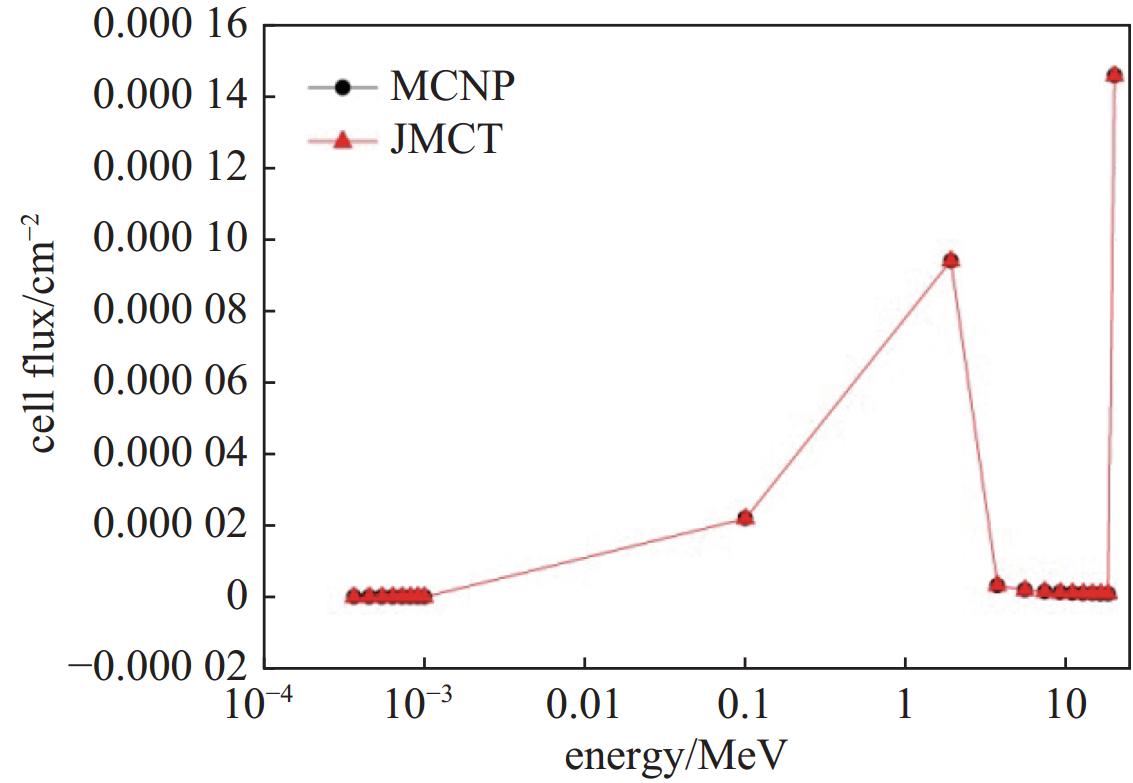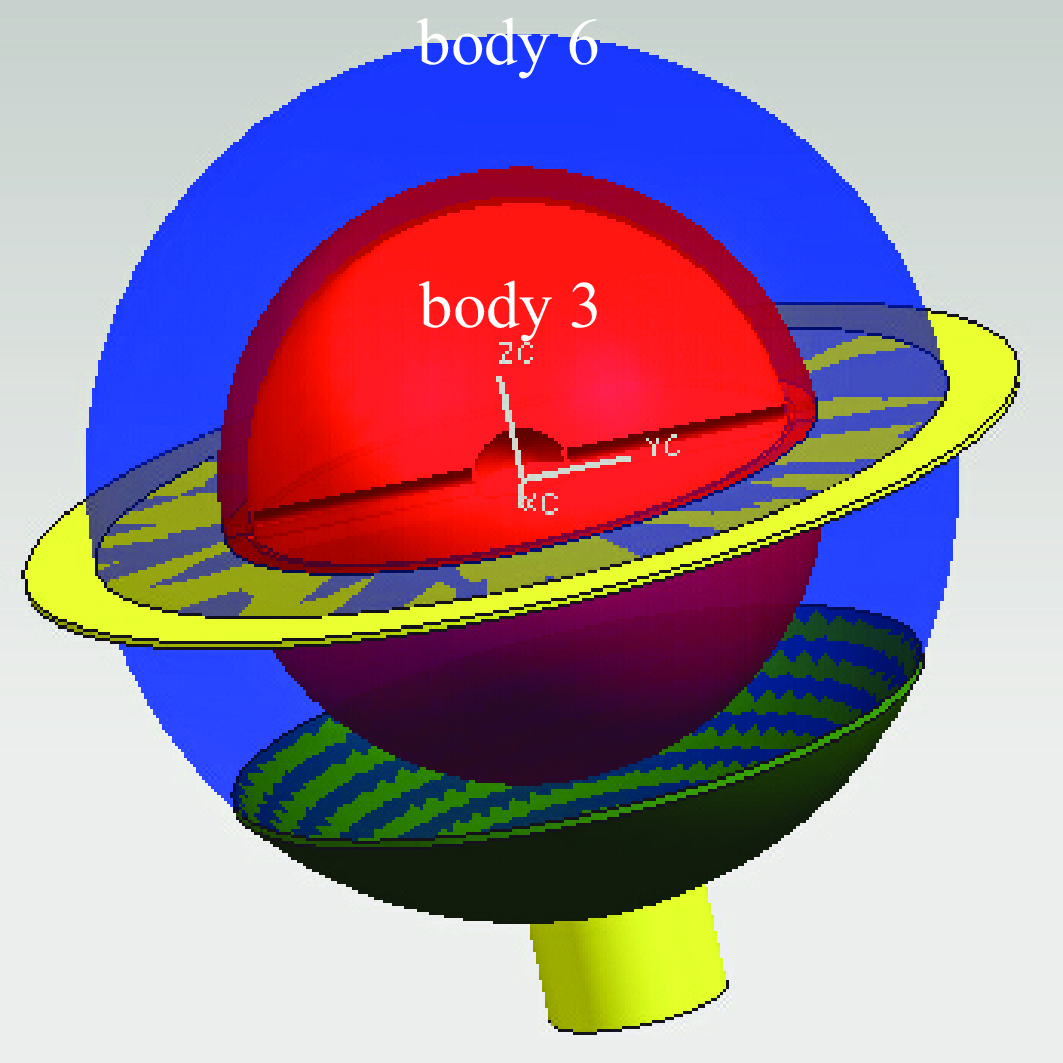Development and tests of functions of proton, low-energy photon and electron transport in JMCT3.0 Monte Carlo particle transport program
-
摘要: 高分辨率通用型三维多粒子输运蒙特卡罗软件JMCT能够模拟任意复杂几何系统的中子/光子/电子/质子/分子/光辐射/大气输运问题,支持数十万核的多级并行,已广泛用于辐射屏蔽、反应堆临界安全分析、核探测及核医学等领域。JMCT已升级到3.0版本,相比2.0版本,3.0版本新增了13项功能,改进发展了8种算法,通过对低层JCOGIN框架的优化,计算效率提高30%~600%。新功能主要用于图像诊断、闪光照相、光辐射及大气输运的模拟。JMCT3.0开发了质子、低能光子/电子及分子模拟功能,通过基准检验,验证了算法的正确有效性。Abstract: The Monte Carlo code JMCT can simulate neutron/photon/electron/proton/molecule/light radiation/atmosphere transport problems in any complicated geometry system. It supports the multi-level parallelization in scale of over one hundred thousand cores. At present, JMCT has been widely applied in radiation shielding, critical safety analysis of reactor, nuclear detection and nuclear medicine etc. JMCT3.0 is a large-scale, high-fidelity, three-dimensional general multi-particle transport Monte Carlo (MC) program, and thirteen new functions and eight new algorithms have been developed based on JMCT2.0. The computing efficiency is enhanced 30%−600% by optimizing of JCOGIN infrastructure. This paper introduces the methods and new functions of proton, low-energy photon/ electron/molecule transport in JMCT3.0. The validity of algorithms has been proved by benchmarks. The new functions are mainly used for simulations of image diagnosis, flash radiography, light radiation and atmosphere transport.
-
Key words:
- Monte Carlo /
- proton /
- low-energy photon and electron transport /
- flash radiography /
- JMCT
-
表 1 水中光子体通量统计计数
Table 1. Statistical tallies of photon volume flux in water
energy/MeV ΦJMCT/cm−2 ΦMCNP6/cm−2 relative deviation/% 6.0000E-04 6.99746E-11 6.99799E-11 − 0.00757 1.0000E-03 5.20906E-09 5.20904E-09 0.000384 total 5.27903E-09 5.27902E-09 0.000189 表 2 水中光子体通量能谱统计计数
Table 2. Statistical energy spectrum tallies of photon volume flux in water
energy/MeV ФJMCT/cm−2 ФMCNP6/cm−2 relative deviation/% 9.18182E-05 4.23205E-12 4.23159E-12 0.01087 1.82636E-04 5.80115E-12 5.80077E-12 0.00655 2.73455E-04 6.19310E-12 6.19268E-12 0.00678 3.64273E-04 7.39524E-12 7.39533E-12 − 0.00122 4.55091E-04 8.70878E-12 8.70836E-12 0.00482 5.45909E-04 9.99978E-12 1.00000E-11 − 0.0022 6.36727E-04 1.13276E-11 1.13266E-11 0.00883 7.27545E-04 1.28006E-11 1.28008E-11 − 0.00156 8.18364E-04 1.43628E-11 1.43626E-11 0.00139 9.09182E-04 1.60751E-11 1.60750E-11 0.000622 1.00000E-03 2.26673E-11 2.26676E-11 − 0.00132 total 1.19563E-10 1.19561E-10 0.00167 -
[1] Deng Li, Ye Tao, Li Gang, et al. 3-D Monte Carlo neutron-photon transport code JMCT and its algorithms[C]//Proceedings of International Conference on Physics of Reactors. 2014. [2] Deng Li, Li Gang, Zhang Baoyin, et al. JMCT V-2.0 Monte Carlo code with integrated nuclear system feedback for simulation of BEAVRS model[C]//PHYSOR 2018. 2018. [3] Deng Li, Li Gang, Zhang Baoyin, et al. A high fidelity general purpose 3-D Monte Carlo particle transport program JMCT3.0[J]. Nuclear Science and Techniques, 2022, 33: 108. doi: 10.1007/s41365-022-01092-0 [4] Zhang Baoyin, Li Gang, Deng Li, et al. JCOGIN: a parallel programming infrastructure for Monte Carlo particle transport[C]//PHYSOR 2014—the Role of Reactor Physics Toward A Sustainable Future. 2014. [5] Mo Zeyao, Zhang Aiqing, Cao Xiaolin, et al. JASMIN: a parallel software infrastructure for scientific computing[J]. Frontiers of Computer Science in China, 2010, 4(4): 480-488. doi: 10.1007/s11704-010-0120-5 [6] Ma Yan, Fu Yuanguang, Qin Guiming. The design of JLAMT: an aided tool for large-scale complex physical modeling[C]//Proceedings of the 40th Anniversary. 2019: 877-883. [7] Cao Yi, Mo Zeyao, Xiao Li, et al. Efficient visualization of high-resolution virtual nuclear reactor[J]. Journal of Visualization, 2018, 21(5): 857-871. doi: 10.1007/s12650-018-0487-1 [8] Li Rui, Zhang Lingyu, Shi Dunfu, et al. Criticality search of soluble boron iteration in MC code JMCT[J]. Energy Procedia, 2017, 127: 329-334. doi: 10.1016/j.egypro.2017.08.118 [9] 邓力, 李瑞, 王鑫, 等. 特征γ射线谱分析的蒙特卡罗模拟技术[J]. 物理学报, 2020, 69:112801 doi: 10.7498/aps.69.20200279Deng Li, Li Rui, Wang Xin, et al. Monte Carlo simulation technology based on characteristic γ-ray spectrum analysis[J]. Acta Physica Sinica, 2020, 69: 112801 doi: 10.7498/aps.69.20200279 [10] Deng Li, Hu Zehua, Li Rui, et al. The coupled neutron transport calculation of Monte Carlo multi-group and continuous cross section[J]. Annals of Nuclear Energy, 2019, 127: 433-436. doi: 10.1016/j.anucene.2018.12.032 [11] Li Gang, Zhang Baoyin, Deng Li. Domain decomposition of combinatorial geometry Monte Carlo transport code JMCT[J]. Transactions of the American Nuclear Society, 2013, 109: 1425-1427. [12] Shangguan Danhua, Li Gang, Deng Li, et al. Tallying scheme of JMCT - a general purpose Monte Carlo particle transport code[J]. Transactions of the American Nuclear Society, 2013, 109: 1428-1430. [13] 李刚, 邓力. BNCT优化网格设计及相关算法研究[J]. 高能物理与核物理, 2006, 30(2):171-177 doi: 10.3321/j.issn:0254-3052.2006.02.018Li Gang, Deng Li. Optimized voxel model construction and simulation research in BNCT[J]. High Energy Physics and Nuclear Physics, 2006, 30(2): 171-177 doi: 10.3321/j.issn:0254-3052.2006.02.018 [14] Zheng Zheng, Wang Mengqi, Li Hui, et al. Application of a 3D Discrete Ordinates-Monte Carlo coupling method to deep-penetration shielding calculation[J]. Nuclear Engineering and Design, 2018, 326: 87-96. doi: 10.1016/j.nucengdes.2017.11.005 [15] 王鑫, 邓力, 李刚, 等. JCOGIN粒子追踪算法优化[J]. 原子能科学技术, 2018, 52(8):1530-1536 doi: 10.7538/yzk.2017.youxian.0778Wang Xin, Deng Li, Li Gang, et al. Optimization for particle tracking algorithm of JCOGIN[J]. Atomic Energy Science and Technology, 2018, 52(8): 1530-1536 doi: 10.7538/yzk.2017.youxian.0778 [16] Berger M J. Monte Carlo calculation of the penetration and diffusion of fast charged particles[R]. Methods in Computational Physics, 1963: 135. [17] Sternheimer R M, Seltzer S M, Berger M J. Density effect for the ionization loss of charged particles in various substances[J]. Physical Review B, 1982, 26(11): 6067-6076. doi: 10.1103/PhysRevB.26.6067 [18] Seltzer S M, Berger M J. Bremsstrahlung spectra from electron interactions with screened atomic nuclei and orbital electrons[J]. Nuclear Instruments and Methods in Physics Research Section B: Beam Interactions with Materials and Atoms, 1985, 12(1): 95-134. doi: 10.1016/0168-583X(85)90707-4 [19] Riley M E, MacCallum C J, Biggs F. Theoretical electron-atom elastic scattering cross sections: selected elements, 1 keV to 256 keV[J]. Atomic Data and Nuclear Data Tables, 1975, 15(5): 443-476. doi: 10.1016/0092-640X(75)90012-1 [20] Kolbenstvedt H. Simple theory for K-ionization by relativistic electrons[J]. Journal of Applied Physics, 1967, 38(12): 4785-4787. doi: 10.1063/1.1709220 [21] Berger M J, Seltzer S M. Bremsstrahlung and photoneutrons from thick tungsten and tantalum targets[J]. Physical Review C, 1970, 2(2): 621-631. doi: 10.1103/PhysRevC.2.621 [22] Grady III H H. Quick-start guide to low-energy photon/electron transport in MCNP6[R]. Los Alamos: Los Alamos National Laboratory, 2013. [23] Hughes H G. Enhanced electron-photon transport in MCNP6[C]//Joint International Conference on Supercomputing in Nuclear Applications. 2013. [24] Goorley J T, James M R, Booth T E, et al. Initial MCNP6 release overview - MCNP6 beta 3[R]. LA-UR-12-26631, Los Alamos: Los Alamos National Laboratory, 2012. [25] NEA. ICSBEP, SINBAD and IRPhEP technical review group meetings[R]. 2019. [26] Chadwick M B, Obložinský P, Herman M, et al. ENDF/B-VII. 0: next generation evaluated nuclear data library for nuclear science and technology[J]. Nuclear Data Sheets, 2006, 107(12): 2931-3060. doi: 10.1016/j.nds.2006.11.001 -





 下载:
下载:







